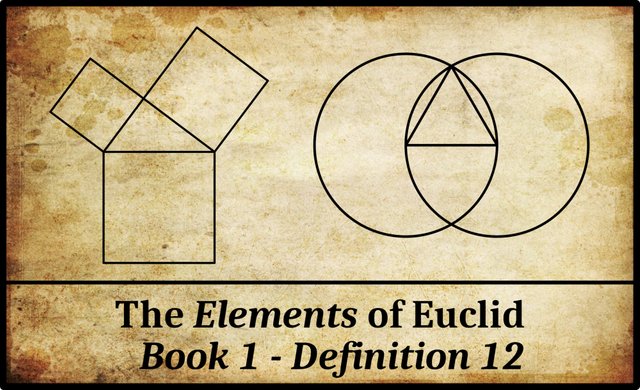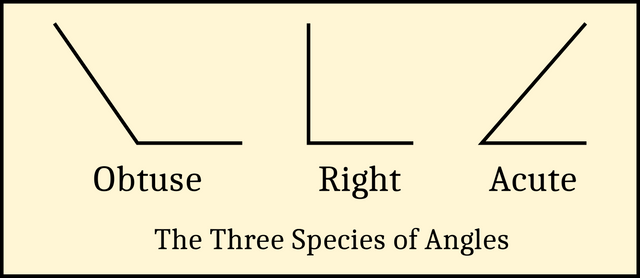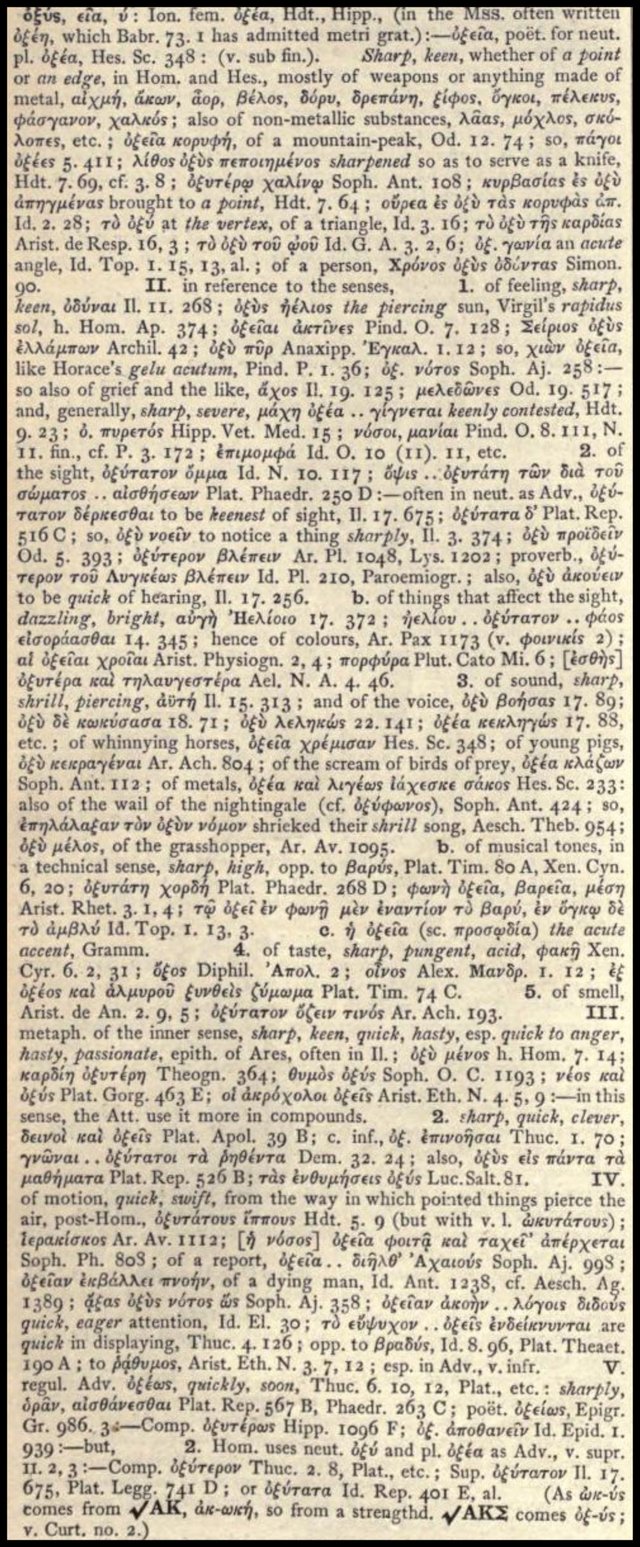
In Book 1 of Euclid’s Elements, Definition 12 reads (Fitzpatrick 6):
| Greek | English |
|---|---|
| ιβʹ. ̓Οξεῖα δὲ ἡ ἐλάσσων ὀρθῆς. | 12. And an acute angle (is) one less than a right-angle. |
In Definition 11, Euclid defined an obtuse angle in terms of the right-angle, which was defined in Definition 10. As we have seen in the last few articles in this series, Euclid makes a distinction between the magnitude of an angle and its measurement. The latter is characterized by a number, but the magnitude of an angle is, as it were, a pre-numerate concept. In terms of magnitudes, one angle may be greater than, less than, or equal to another angle. In other words, angular magnitudes can be compared to one another, but without the metrical concept of numerical measurement we cannot be more specific than this. We cannot say, for example, that one angle is twice as big as another angle, or half as big.
An acute angle, therefore, is an angle whose magnitude is less than that of a right-angle. Nothing is said about the metrical measurement of acute angles. Furthermore, as in his definition of obtuse angles, he does not specify that an acute angle be rectilinear:
Note that there is no requirement that the angle be rectilinear; indeed, the horn angles mentioned before are not rectilinear, but they are less than right angles, and so are acute (notwithstanding Proclus’ remarks to the contrary). (Joyce)
It is not clear from Definitions 11 and 12 whether Euclid intends to restrict the terms obtuse and acute to rectilinear angles. Proclus believes he does:
To the definitions of the obtuse and acute angles we must add the genus: each of them is rectilinear, one larger and the other smaller than a right angle. Not every angle smaller than a right angle is acute, for the horned angle is smaller than any right angle—indeed smaller than any acute angle—but is not acute; and likewise the semicircular angle is smaller than any right angle but is not acute. The explanation is that these are mixed, not rectilinear angles. Clearly also many angles contained between circular lines appear to be greater than right angles, but they are not for that reason obtuse; for the obtuse angle must be rectilinear. (Morrow 107-108)
Proclus defends this emendation of Euclid’s definitions on the grounds that Euclid does not specify that obtuse and acute angles be plane angles (as defined in Definition 8), though this is universally acknowledged to be the case:
In addition to what has been said, I think it proper to recall here also the purpose of the author of the Elements, that he is discoursing about the figures constructed in a single plane. (Morrow 108)

Three Kinds of Angles
Definitions 10-12 define three different kinds of angles. Before Euclid, geometers generally divided all plane angles into these three genera. Plato even contends that the partitioning of plane angles into these three genera is an unproven assumption from which geometers reason:
I think you know that students of geometry, calculation, and the like hypothesize the odd and the even, the various figures, the three kinds of angles, and other things akin to these in each of their investigations, as if they knew them. They make these their hypotheses and don’t think it necessary to give any account of them, either to themselves or to others, as if they were clear to everyone. And going from these first principles through the remaining steps, they arrive in full agreement. (Plato, Republic 510 c : Cooper 1131)
In Book 13 of the Metaphysics, Aristotle discusses the priority of the right angle and the acute angle:
And in a sense the right angle is prior to the acute, because it is definite and in virtue of its formula; but in a sense the acute is prior, because it is a part and the right angle is divided into acute angles. As matter, then, the acute angle and the element and the unit are prior, but as regards the form and the substance (in the sense of the formula), the right angle, and the whole consisting of the matter and the form, are prior; for the compound thing is nearer the form and the object of the formula, but in generation it is later. (Aristotle, Metaphysics 1084 b : Barnes 3682)
This distinction between logical priority and material priority was foreshadowed in Book 7 of the Metaphysics:
The parts of the formula, into which the formula is divided, are prior to it, either all or some of them. The formula of the right angle, however, does not include the formula of the acute, but the formula of the acute includes that of the right angle; for he who defines the acute uses the right angle; for the acute is less than a right angle. (Aristotle, Metaphysics 1035 b : Barnes 3516)

Terminology
The Greek word Euclid uses for acute is ὀξεῖα [oxeia]. This is the feminine nominative singular form of the adjective ὀξύς [oxus], which means sharp, keen, acute. In ancient Greek, the word was used in the literal sense (a sharp weapon), the figurative sense (keen eyesight), and the geometric sense (an acute angle).
And that’s a good place to stop.
References
- Jonathan Barnes (editor), The Complete Works of Aristotle, Volumes 1 & 2, Princeton University Press, Princeton, NJ (1984)
- John M Cooper, Plato: Complete Works, Hackett Publishing Company, Indianapolis (1997)
- Richard Fitzpatrick (translator), Euclid’s Elements of Geometry, University of Texas at Austin, Austin, TX (2008)
- Thomas Little Heath (translator & editor), The Thirteen Books of Euclid’s Elements, Second Edition, Dover Publications, New York (1956)
- Johan Ludvig Heiberg, Heinrich Menge, Euclidis Elementa edidit et Latine interpretatus est I. L. Heiberg, Volumes 1-5, B G Teubner Verlag, Leipzig (1883-1888)
- Henry George Liddell, Robert Scott, A Greek-English Lexicon, Eighth Edition, American Book Company, New York (1901)
- Glenn R Morrow (translator), Proclus: A Commentary on the First Book of Euclid’s Elements, Princeton University Press, Princeton, NJ (1970)
Online Resources
